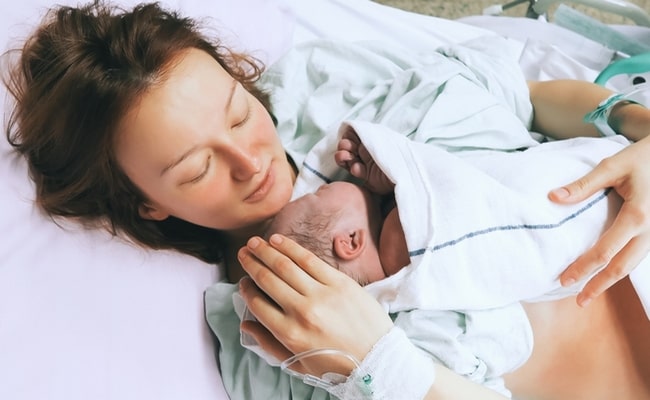What is Third Stage of Labor?
Third stage of labor extends from delivery of the foetus up to the delivery of placenta and membranes. The part of labor from the birth of the baby until the placenta (afterbirth) and fetal membranes are delivered. The third stage of labor is also called the placental stage.

Clinical Features of Third Stage of Labor:
1. Pain: For a short time, the pt. experience no pain. Immediately following expulsion of the foetus, mother feels a sign of relief.
2. Before separation of placenta:
a. Per abdomen-
- Uterus becomes, firm, non ballotable.
- Fundal height reaches slightly below umbilicus.
b. Per vagina-
- There may be slight trickling of blood.
- Length of umbilical cord as visible from outside, remain static.
3. After separation of placenta:
a. Per abdomen-
- Uterus becomes globular, firm contracted,
- Fundal height is slightly raised,
- Slight bulging in supra pubic region.
b. Per vagina
- Gush of vaginal bleeding,
- Permanent lengthening of the cord.
4. Expulsion of placenta & membranes:
- Marked retraction reduces effectively the surface area at the placenta about its half.
- But as the placenta is inelastic, it cannot keep pace with such an extent of diminution resulting in its buckling.
- A shearing force is instituted between the placenta & the placenta site which bring about its ultimate separation.
- The plane of separation runs through deep spongy layer of deciduas basils so that a variable thickness of decides covers the maternal surface of the separated placenta.
Management of Third Stage of Labor:
There are two types of management of third stage of labor;
- Expectant management
- Active management
All the above two types of management have discussed in the following:
A. Expectant management:
- Delivery of the baby.
- Clamping and cutting of the umbilical cord.
- Constant monitoring is mandatory and the patient should not be left alone.
- Provide psychological support to the mother.
- If the mother is delivered in the lateral position, she should be changed in the dorsal position to note the features of placental separation and to assess the amount of blood loss.
- Wait & watch for sign of placental separation.
- Wait for spontaneous expulsion of placenta with the aid of gravity.
- If fails, assisted expulsion is done by-
- Inj-oxytocin, 5-10 units IV or IM
- If fails, control cord traction & fundal pressure.
9. Examination of placenta, membrane and umbilical cord.
10. Inspection of the vulva, vagina and perineum is done.
B. Active management:
Active management of third stage of labor includes;
- Immediate oxytocin,
- Controlled cord traction (CCT),
- Uterine massage.
These are maintained through the following steps;
- Just after delivery, palpate the mother’s abdomen to exclude the second baby.
- Give 10unit oxytocin intramuscularly.
- Clamp the cord close to the perineum with forceps.
- Use one hand to grasp the forceps.
- Place other hand on mother’s abdomen, with the palm facing toward the mother’s umbilicus & gently apply pressure in an upward direction (counter traction).
- Firmly apply traction to the cord, in a downward direction, using the hand that is grasping the forceps.
- Apply steady tension by pulling the cord firmly & maintaining pressure.
- When the placenta is visible at the vaginal opening, cup it in both hands.
- Use a gentle upward & downward movement or twisting movement to deliver the membrane.
- Place the placenta in a kidney tray.
- Gentle massages the uterus & make sure that uterus is well contracted.
Complication of Third Stage of Labour:
All the complications of third stage of labourhave listed in the below:
- Retained placenta,
- Uterine inversion,
- Obstetric inversion,
- Obstetric shock,
- Pulmonary embolism (amniotic fluid/air embolism),
- PPH due to-
- Uterine inertia,
- Maternal injury,
- Retained placental bits.

Maria Khatun Mona is a Founder and Editor of Nursing Exercise Blog. She is a Nursing and Midwifery Expert. Currently she is working as a Registered Nurse at Evercare Hospital, Dhaka, Bangladesh. She has great passion in writing different articles on Nursing and Midwifery. Mail her at “maria.mona023@gmail.com”
